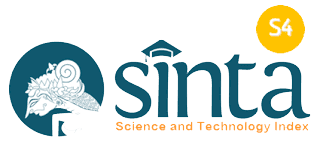The Effect of Financial Leverage, Operating Leverage and Current Ratio on Profitability at PT. Manunggal Persada Jakarta
(1) Universitas Pemulang
(*) Corresponding Author
DOI: https://doi.org/10.26858/pdr.v3i2.13259
Abstract
Funds can be obtained from company owners or from outside parties. The purpose of this study was to determine the effect of financial leverage, operating leverage and current ratio on profitability at PT. Manunggal Persada Jakarta. The method used in this research is descriptive with an associative approach, the sampling technique used is proportional random sampling using the census or saturated sampling method with a sample of 7 years of financial statements. The analysis tool uses classical assumption testing, regression testing, determination coefficient testing and hypothesis testing. The results of the study concluded that the regression coefficient value of Financial leverage of 0.005 was positive with a contribution of 19.3%. Hypothesis testing obtained a significance value of 0.324> 0.05. Regression coefficient value of Operating leverage of 0.001 is positive with a contribution of 16.5%. Hypothesis testing obtained a significance value of 0.368> 0.05. Current coefficient regression value of 0.158 is positive with a contribution of 31.9%. Hypothesis testing obtained a significance value of 0.187> 0.05. Obtained a regression equation Y = 0.110 + 0.009X1 + 0.001X2 + 0.177X3, the regression coefficient value of each positive independent variable with a correlation of 0.927 and a coefficient of determination of 85.8% while the remaining 14.2% is influenced by other factors. Hypothesis testing obtained by calculating Fcount> Ftable or (6.064> 4.120). Thus simultaneously there is a positive and significant effect between financial leverage, operating leverage and current ratio to rentability.
Keywords
Full Text:
PDFReferences
Andersen, T. G., Bollerslev, T., Christoffersen, P. F., & Diebold, F. X. (2013). Financial Risk Measurement for Financial Risk Management. In Handbook of the Economics of Finance. https://doi.org/10.1016/B978-0-44-459406-8.00017-2
Bredmar, K. (2017). Change management. In The Routledge Companion to Accounting Information Systems. https://doi.org/10.4324/9781315647210
Brigham, E. F., & Houston, J. F. (2013). Dasar-Dasar Manajemen Keuangan. Salemba Empat. https://doi.org/10.1145/2505515.2507827
Christoffersen, P. F. (2003). Elements of Financial Risk Management. In Elements of Financial Risk Management. https://doi.org/10.1016/B978-0-12-174232-4.X5000-4
Dempsey, M. (2017). Financial Leverage. In Stock Markets and Corporate Finance. https://doi.org/10.1142/9781786343277_0008
Ekawati, E. (2014). Manajemen Keuangan. Modul Kuliah. https://doi.org/10.1016/S0044-8486(98)00413-X
Erari, A. (2014). Analisis Pengaruh Current Ratio, Debt To Equity Ratio, dan Return On Asset Terhadap Return Saham Pada Perusahaan Pertambangan di Bursa Efek Indonesia. Jurnal Manajemen Bisnis Universitas Muhammadiyah Yogyakarta.
Horne, J.C. dan Wachowicz, J. M. (2007). Prinsip-Prinsip Manajemen Keuangan. In Prinsip-Prinsip Manajemen Keuangan. https://doi.org/10.4324/9781315641348
PA, M., & Marbun, D. (2016). Pengaruh Current Ratio Dan Debt To Equity Ratio Terhadap Return On Assets. WIDYAKALA JOURNAL. https://doi.org/10.36262/widyakala.v3i0.21
Siegrist, A., & Chambaz, M. (2012). Financial accounting. In Essentials of Logistics and Management, the Global Supply Chain, Third Edition. https://doi.org/10.1201/b16379
Sunarsi, D. (2018). Pengaruh Motivasi Dan Disiplin Terhadap Produktivitas Kerja Karyawan Pada PT. Nadi Suwarna Bumi. Jurnal Semarak, 1(1).
Sunarsi, D., Kustini, E., Lutfi, A. M., Fauzi, R. D., & Noryani, N. (2019). Penyuluhan Wirausaha Home Industry Untuk Meningkatkan Ekonomi Keluarga Dengan Daur Ulang Barang Bekas. BAKTIMAS: Jurnal Pengabdian pada Masyarakat, 1(4), 188–193.
Suryo, M. Sistem Informasi, Keuangan, Auditing Dan Perpajakan. , Sistem Informasi, Keuangan, Auditing, Perpajakan (2018).
Susilawati, C. D. K. (2012). Analisis Perbandingan Pengaruh Likuiditas , Solvabilitas , dan Profitabilitas Terhadap Harga Saham pada Perusahaan LQ 45. Jurnal Akuntansi.
Sutrisno. (2013). Manajemen Keuangan Teori Konsep dan Aplikasi. In Manajemen Keuangan Teori Konsep dan Aplikasi.
Utami, M. (2015). Pengaruh Aktivitas, Leverage , dan Pertumbuhan Perusahaan dalam Memprediksi Financial Distress. Artikel. Universitas Negeri Padang.
Wang, P. (2005). Financial Econometrics. In Financial Econometrics. https://doi.org/10.4324/9780203990735
Widati, L. W., & Pratama, B. A. (2015). Pengaruh Current Ratio, Debt to Equity Ratio, dan Return On Equity, Untuk Memprediksi Kondisi Financial Distress. Proceeding Sendi_u.
Widiyanti, M., & Elfina, F. D. (2015). Pengaruh Financial Leverage terhadap Profitabilitas pada Perusahaan Sub Sektor Otomotif dan Komponen yang Terdaftar di Bursa Efek Indonesia. Jurnal Manajemen dan Bisnis Sriwijaya Bisnis.
Wong, K. L. (2006). Financial management. In Professional Housing Management Practices in Hong Kong. https://doi.org/10.5005/jp/books/10677_12
Article Metrics
Abstract view : 519 times | PDF view : 126 timesRefbacks
- There are currently no refbacks.
Copyright (c) 2020 Waluyo Jati


































